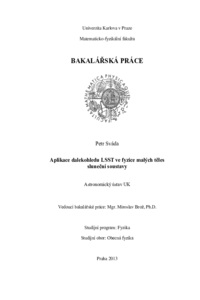Aplikace dalekohledu LSST ve fyzice malých těles sluneční soustavy
The application of the LSST in the physics of the small solar-system bodies
bachelor thesis (DEFENDED)

View/
Permanent link
http://hdl.handle.net/20.500.11956/58470Identifiers
Study Information System: 63278
Collections
- Kvalifikační práce [10690]
Author
Advisor
Consultant
Ďurech, Josef
Prouza, Michael
Referee
Wolf, Marek
Faculty / Institute
Faculty of Mathematics and Physics
Discipline
General Physics
Department
Astronomical Institute of Charles University
Date of defense
29. 1. 2014
Publisher
Univerzita Karlova, Matematicko-fyzikální fakultaLanguage
Czech
Grade
Very good
Keywords (Czech)
dalekohled LSST, signál a šum, mezní hvězdná velikost, planetky hlavního pásuKeywords (English)
LSST telescope, signal and noise, limiting magnitude, main belt asteroidsTato práce se zabývá popisem velkého přehlídkového dalekohledu Large Synoptic Survey Telescope (LSST) a jeho využítím ve fyzice malých těles sluneční soustavy. Na základě optických parametrů dalekohledu a teorie signálu a šumu jsme vypočetli mezní hvězdnou velikost LSST (24,9 0,4) mag (v oboru V). Tato veličina, společně s daty z databází MPC a WISE, posloužila jako vstupní parametr pro výpočet minimálního průměru ( ) m planetky v hlavním pásu, kterou bude LSST ještě schopen pozorovat. Odhadli jsme také, že v hlavním pásu bude možno pomocí dalekohledu LSST pozorovat ( ) miliónů planetek. S přihlédnutím k plánované observační strategii a kadenci pozorování jsme vypočetli, že bude určitou jasnou planetku pozorovat přibližně 370 krát. Nakonec byly diskutovány možné aplikace dalekohledu LSST: např. rozvoj kolizních modelů, objasnění orbitální a rotační dynamiky sub- kilometrových těles.
This thesis is devoted to the description of the Large Synoptics Survey Telescope (LSST) and its use in the physics of small solar-system bodies. Based on the telescope optics parameters and the theory of signal and noise we calculate limiting magnitude of the LSST (24,9 0,4) mag (in the V band). This value, together with data from MPC and WISE databases, serve as an input parameter for the calculation of the minimum diameter ( ) m of a main-belt asteroid, that LSST will be able to observe. We also estimated that (160 ± 118) million asteroids could be observable by the LSST. Taking into account the planned observational strategy and cadence, we calculated that a sufficiently bright asteroid will be observed approximately 370 times. Finally, the possible applications of the LSST are discussed: e. g. a development of collisional models, explanation of orbital and rotational dynamics of sub-kilometer objects.
